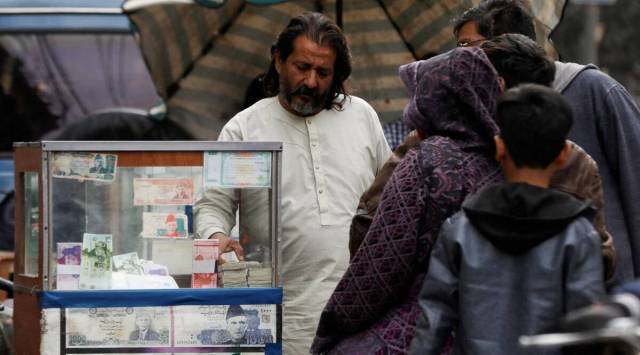
Written by Umair Javed
On January 30, an IMF delegation arrived in Pakistan to hold talks with the country’s finance minister for the revival of a stalled Extended Fund Facility. In the same week, the Pakistani rupee plummeted nearly 20 per cent against the US dollar, as an artificial peg on the currency was removed to meet a key condition of the multilateral lender. Further conditions include price-hikes in electricity and gas tariffs, and the imposition of a set of new taxes which after weeks of delays, are expected within February. The panicked urgency comes as foreign exchange reserves dropped to their lowest in nearly three decades, providing import cover of just around three weeks.
Pakistan’s current economic crisis is similar to what several other, import-dependent economies are facing. The strengthening dollar and uncertain global economic conditions mean that a number of states are struggling with import bills and debt repayments.
Pakistan’s economy is no stranger to large current account deficits and balance of payment crises. What is equally familiar is the episodic turn to the IMF to provide a short-term solution. The current EFF, signed in July 2019, is the country’s 23rd agreement with the lender in its 75 years as an independent state.
On the day the IMF mission landed in Pakistan, Murtaza Syed, a former deputy governor of Pakistan’s central bank laid out the chronology of the current crisis in a succinct op-ed. The contours are painfully familiar – from 2021 onwards, growth was pursued on a fragile economic base, prioritising domestic consumption and investment in unproductive sectors like real estate. Imports grew rapidly while exports and other sources of foreign exchange, including support from “friendly countries” – Gulf Cooperation Council (GCC) allies and China – failed to keep up. To stave off political pressures in a high-inflation environment, successive governments – the PTI-led one till April 2022, and the PDM coalition government that replaced it since then – refused to adjust fuel and energy prices to changing global conditions. The end result was an alarmingly high pace of forex reserve depletion that brought the country back to the IMF.
That the IMF is asking for a raft of unpopular stabilisation decisions to stave off a payments crisis is par for the course. What deserves greater scrutiny is the underlying reasons that make a trip to the lender such a frequent occurrence. One can opt for a story of poor policy decisions, which would of course be valid. The decision to give a fuel subsidy was a poor one. The decision to peg the Pakistan rupee’s value to the dollar for over four months was supremely misplaced.
But these policy decisions, and the weakness of an economy that can’t afford economic growth without ending up in IMF-led rehab, point to deeper, political issues. The most important of which is the power of vested interests that capture state largesse, and the recurring pursuit of short-term political gains by successive governments. The outcome of both is an economy mired in domestic consumption and low productivity, anchored to a narrow tax base.
Economist Hafiz Pasha estimates that political, military, industrial, and landed elites consume subsidies to the tune of 8 per cent of GDP (nearly US $24 billion). These include hand-outs, such as subsidised energy and protective tariffs to industrialists and military-owned businesses that end up creating captive local markets, instead of promoting greater productivity. They suppress the exchange rate with borrowed or gifted dollars to prioritise importers who fuel local consumption and hamper exports. The granting of thousands of acres of agricultural and residential land as privileges of military service skews land prices and redirects capital towards speculative real estate practices. Under pressure from landholders, legislators have refused to appropriately tax urban property or income from large agricultural holdings. Similarly, retail/wholesale traders have used their clout to stall taxation measures.
The list of such politically-determined claims on a frequently fledgling economy is large and seems to be growing. From a historical perspective, many of these current patterns can be traced to the early 2000s — to the military regime of the recently deceased General Pervez Musharraf. Often presented as a golden period of growth by regime allies and supporters, the period should be viewed as one in which the unproductive and consumerist basis of the economy was actually laid. Between 2001 and 2007, the inflow of the War on Terror funds sustained dollar liquidity and an artificial fix of the PKR-USD rate, resulting in a middle-class binge on consumer goods (textiles, motor vehicles, and white goods), a stagnation of exports, and a massive rise in unproductive real estate investment.
Overnight, untaxed fortunes were made by speculating on empty land or buying and selling cheap imports, while formal domestic investment plummeted to regional lows. It may have helped placate dominant social groups and shore-up support for the regime for a few years, but it was incurred at a large, long-term cost. In the years since, the political dynamics that sustain these practices have largely continued unabated. Governments worried about their popularity – either because of internal dissension of the elites that brought them to power, opposition pressure, or machinations of the military – opt for short-term appeasement, rather than fixing, deep-rooted structural flaws.
As is so frequently the case with IMF involvement, the way forward looks painful for Pakistani society. And as always the pain will be borne by regular citizens, already struggling with year-on-year inflation of 27 per cent, a rate not seen since 1975. The question thus confronting decision-makers is whether they’ll finally untether the country from a political structure that causes repeated economic crises, or will they find themselves returning for another round of painful adjustment in a year or two.
The writer teaches politics and development at the Lahore University of Management Sciences (LUMS)